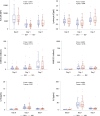Maintaining ventilation with very low tidal volume and positive-end expiratory pressure versus no ventilation during cardiopulmonary bypass for cardiac surgery in adults: a randomized clinical trial
- PMID: 40323450
- PMCID: PMC12130150
- DOI: 10.1007/s00134-025-07901-5
Maintaining ventilation with very low tidal volume and positive-end expiratory pressure versus no ventilation during cardiopulmonary bypass for cardiac surgery in adults: a randomized clinical trial
Abstract
Purpose: Cardiopulmonary bypass (CPB) during cardiac surgery mechanically circulates and oxygenates the blood, bypassing the heart and lungs. Despite limited evidence, maintaining mechanical ventilation (MV) during CPB is recommended, as ventilator strategies during surgery may reduce the occurrence of postoperative infections. We aimed to determine whether maintaining MV for cardiac surgery would decrease postoperative infections compared with stopping MV during CPB.
Methods: We conducted a multicenter, single-blind, randomized trial among adult patients undergoing scheduled cardiac surgery with CPB in six hospitals in France. During CPB, the tracheal tube was disconnected from the ventilator in the control group (MV- group). In the MV + group, ventilation was maintained during CPB with very low tidal volume ventilation, using a tidal volume of 2.5 mL/kg of predicted body weight, with 5-7 cmH2O positive end expiratory pressure. The primary outcome was the occurrence of all types of postoperative infections within the first 28 days after surgery. There were six secondary evaluation criteria including the number of days of exposure to antibiotics.
Results: A total of 1362 patients were enrolled in the study. Postoperative infection occurred in 74 out of 680 patients (10.9%) in the MV- group, compared to 68 out of 682 patients (10.0%) in the MV + group (relative risk, 0.92; 95% confidence interval [CI] 0.67-1.25; p = 0.58). Antibiotic use was higher in the MV + group than in the MV- group (incidence risk ratio, 1.08; 95% CI 1.02-1.15; p = 0.02). There were no significant differences between the groups for all other secondary outcomes or for the incidence of adverse events.
Conclusions: Maintaining very low tidal volume ventilation with positive end-expiratory pressure during CPB did not reduce postoperative infections at 28 days compared to when mechanical ventilation was stopped during CPB. An unexpectedly higher use of antibiotics was observed when ventilation was maintained.
Trial registration: ClinicalTrials.gov (NCT03372174).
Keywords: Cardiac surgery; Cardiopulmonary bypass; Mechanical ventilation; Postoperative infection.
© 2025. The Author(s).
Conflict of interest statement
Declarations. Conflicts of interest: We declare no competing interests.
Figures



References
-
- Aneman A, Brechot N, Brodie D, Colreavy F, Fraser J, Gomersall C, McCanny P, Moller-Sorensen PH, Takala J, Valchanov K et al (2018) Advances in critical care management of patients undergoing cardiac surgery. Intensive Care Med 44(6):799–810 - PubMed
-
- Segers P, Speekenbrink RG, Ubbink DT, van Ogtrop ML, de Mol BA (2006) Prevention of nosocomial infection in cardiac surgery by decontamination of the nasopharynx and oropharynx with chlorhexidine gluconate: a randomized controlled trial. JAMA 296(20):2460–2466 - PubMed
-
- Sbrana S, Bevilacqua S, Buffa M, Spiller D, Parri MS, Gianetti J, De Filippis R, Clerico A (2005) Post-reperfusion changes of monocyte function in coronary blood after extracorporeal circulation. Cytometry B Clin Cytom 65(1):14–21 - PubMed
Publication types
MeSH terms
Associated data
Grants and funding
LinkOut - more resources
Full Text Sources
Medical

